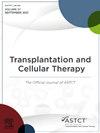UCBT治疗儿童CAEBV的临床结果:单中心回顾性分析
IF 3.6
3区 医学
Q2 HEMATOLOGY
引用次数: 0
摘要
背景:慢性活动性eb病毒(CAEBV)感染是一种严重的、危及生命的疾病,其特征是持续的eb病毒(EBV)感染和受感染的T或NK细胞的克隆扩增,导致全身炎症、器官损伤和并发症,如噬血细胞性淋巴组织细胞增多症和淋巴瘤。同种异体造血干细胞移植(HSCT)是根除ebv感染细胞的唯一有效治疗方法;然而,捐助者是有限的。脐带血干细胞移植(UCBT)由于其快速可用性和较低的并发症风险,是一种很有前途的替代方法。然而,关于小儿CAEBV患者的UCBT的现有报道较少。目的:本研究旨在评估UCBT作为儿科CAEBV潜在治疗方法的可行性和临床疗效。研究设计:我们调查了2016年至2022年间在中国郑州大学第一附属医院和郑州人民医院接受UCBT的CAEBV儿童,这些儿童没有匹配的供体。我们回顾性分析本组病例的临床特点、前处理方案、移植相关并发症及临床结局,探讨UCBT治疗儿童CAEBV的疗效。结果:8例患者入组,其中男4例,女4例,诊断年龄4(1-8)岁,移植年龄4(2-8)岁。从诊断到移植的平均时间为5(2-14)个月。存活患者平均随访时间49.75±29.66个月,最长随访时间101.0个月。8例患者均成功植入。急性GVHD 6例,慢性GVHD 1例,病情较轻。2例发生巨细胞病毒再激活。未观察到EBV再激活和移植后淋巴细胞增生性疾病(PTLD)。病例4在ucbt后10个月复发,并在随后的父亲单倍同卵HSCT后获得生存。病例8在移植后第50天死于血栓性微血管病变(TMA)。随访结束时,3年总生存率(OS)估计为87.5%(95%可信区间[CI]: 0.529-0.994)。3年EFS发生率估计为75% (95% CI: 0.409-0.956)。估计3年GRFS率也为75.0% (95% CI: 0.409-0.956)。结论:UCBT是一种安全有效的儿童CAEBV治疗方法,可作为无匹配供体或紧急移植患者的可行替代方案。本文章由计算机程序翻译,如有差异,请以英文原文为准。
Clinical Outcome of UCBT for Children With CAEBV: A Retrospective Analysis of a Single Center
Chronic active Epstein–Barr virus (CAEBV) infection is a severe, life-threatening condition characterized by persistent Epstein–Barr virus (EBV) infection and the clonal expansion of infected T or NK cells, leading to systemic inflammation, organ damage, and complications such as hemophagocytic lymphohistiocytosis and lymphoma. Allogeneic hematopoietic stem cell transplantation (HSCT) is the only effective treatment for eradicating EBV-infected cells; however, donor availability is limited. Umbilical cord blood stem cell transplantation (UCBT) is a promising alternative owing to its rapid availability and lower complication risk. However, there are fewer existing reports on UCBT in pediatric patients with CAEBV. This study aimed to assess the feasibility and clinical efficacy of UCBT as a potential treatment for pediatric patients with CAEBV. We investigated children with CAEBV who did not have matched donors and underwent UCBT in the First Affiliated Hospital of Zhengzhou University and Zhengzhou People's Hospital, China, between 2016 and 2022. We retrospectively analyzed the clinical characteristics, pretreatment regimens, transplantation-related complications, and clinical outcomes of this group of cases to explore the efficacy of UCBT in CAEBV treatment in children. Eight patients, including four males and four females, with a diagnosis age of 4 (1 to 8) years and a transplantation age of 4 (2–8) years, were enrolled in this study. The mean time from diagnosis to transplantation was 5 (2 to 14) months. The mean follow-up period for surviving patients was 49.75±29.66 months, with a maximum follow-up of 101.0 months. All eight patients exhibited successful engraftment. Acute GVHD was observed in six patients, while chronic GVHD was observed in only one patient, with the case being relatively mild. 2 patients developed CMV reactivation. EBV reactivation and post-transplant lymphoproliferative disease (PTLD) were not observed. Case 4 experienced relapse 10 months post-UCBT and achieved survival following a subsequent haplo-identical HSCT from her father. Case 8 succumbed to thrombotic microangiopathy (TMA) on post-transplant day 50. By the end of the follow-up, the 3-year overall survival rate (OS) was estimated to be 87.5% (95% CI: 0.529 to 0.994). The 3-year EFS rate was estimated to be 75% (95% CI: 0.409 to 0.956). The estimated 3-year GRFS rate was also 75.0% (95% CI: 0.409–0.956). UCBT emerges as a safe and effective treatment for CAEBV in children, serving as a viable alternative for patients without matched donors or emergency transplantation.
求助全文
通过发布文献求助,成功后即可免费获取论文全文。
去求助
来源期刊

Transplantation and Cellular Therapy
Medicine-Hematology
CiteScore
7.00
自引率
15.60%
发文量
1061
审稿时长
51 days
 求助内容:
求助内容: 应助结果提醒方式:
应助结果提醒方式:


